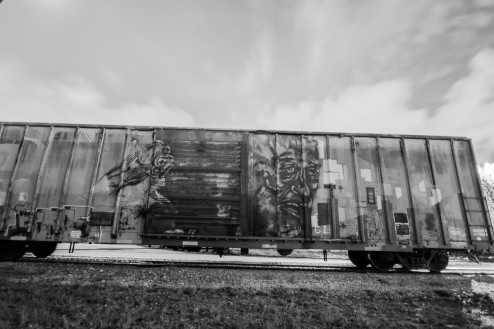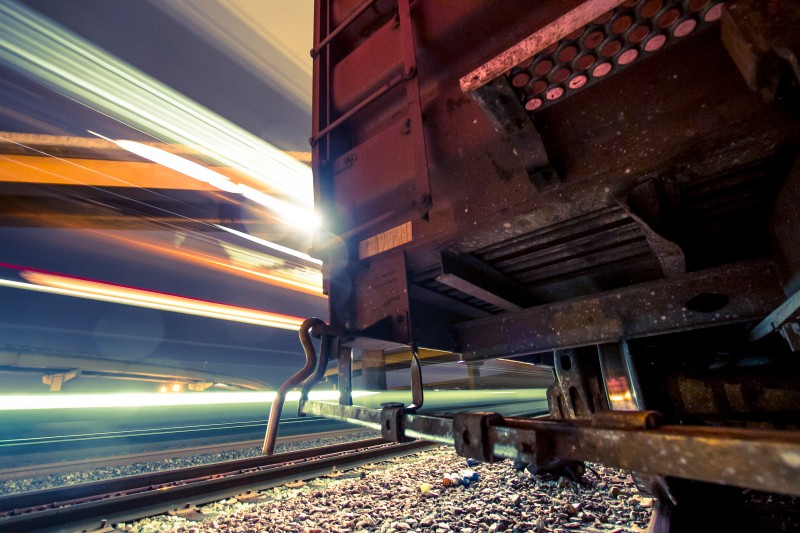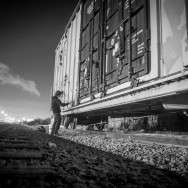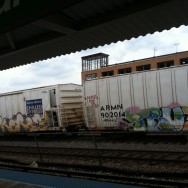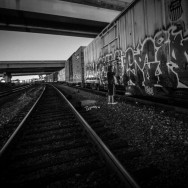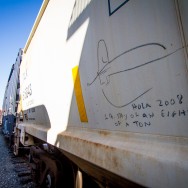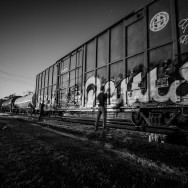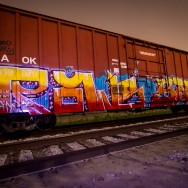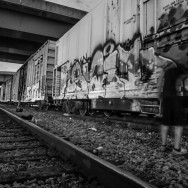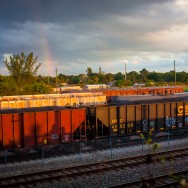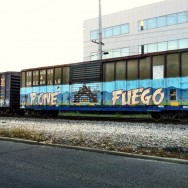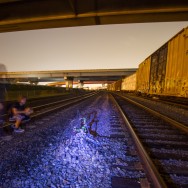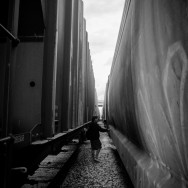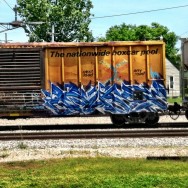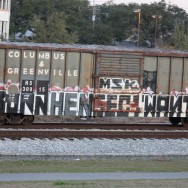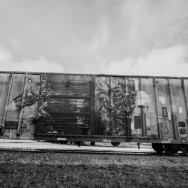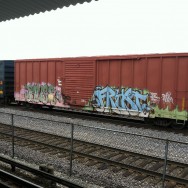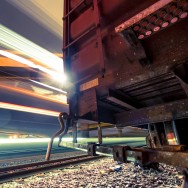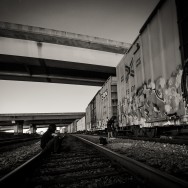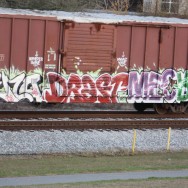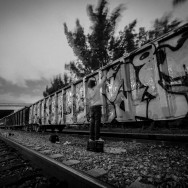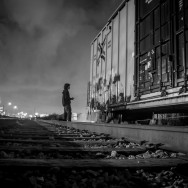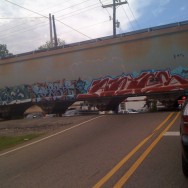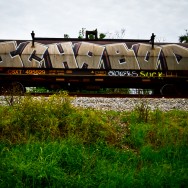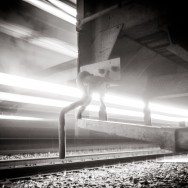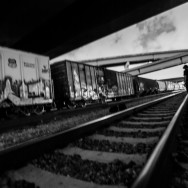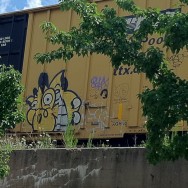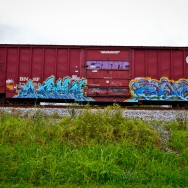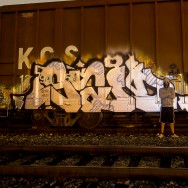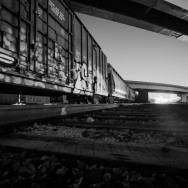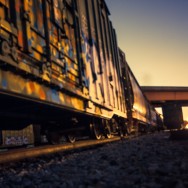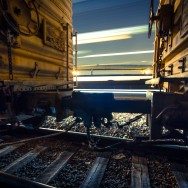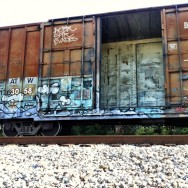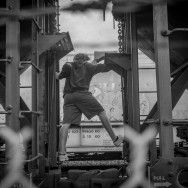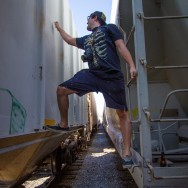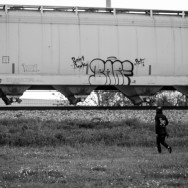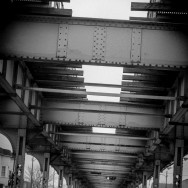(Quick disclaimer: I am neither a participant or accessory in painting freight trains. These photos and words come from the viewpoint of an outside observer.)
At the mentions of freight trains and railroads, the minds of the general public will most likely travel to a place of childhood memories, handling HO scale models and watching the giant steel boxes roll by with a sense of wonder. In a small corner of society, this childhood enthusiasm has survived, even thrived, well into adulthood. These are the railfans: people who love trains, what they represent, and the culture surrounding them.
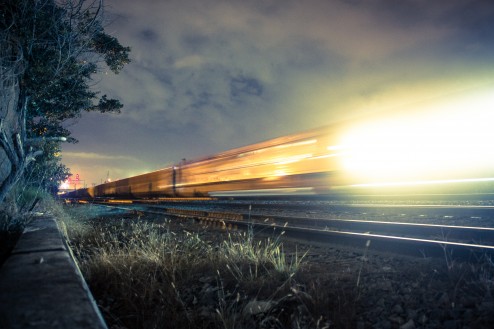
I had always taken a mild notice to trains… In my hometown of Oak Park, IL. there is an elevated line of tracks that intersects the township east to west. There are transit lines as well as freight lines running on it, and I can remember seeing graffiti on trains rolling through town from a very early age. In fact, this constant exposure of decorated boxcars is probably what sparked my interest in graffiti and street art from the get-go. Since coming to Miami, I have definitely begun to take more of an interest in train culture. They have grown increasingly fascinating to me, and not just because of the group of people who risk their freedom to paint them, but also because of what they represent in relation to their function and our country: Infrastructure. Manifest Destiny. America.
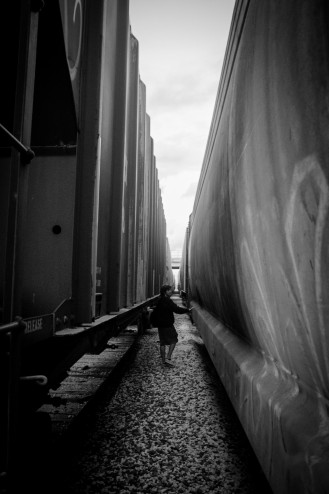
Shortly after arriving in Miami I met some folks that definitely occupy this aforementioned corner of society.. Train-seekers, boxcar children. After joining them on a few freight-centric adventures, the steel-bug had taken hold of me as well. I began to perk up at the site of a train, like a dog does when a squirrel runs by. The sight of a properly painted train car, or a kind of boxcar that I had never seen before began to excite me in inexplicable ways. Many who end up reading this will never understand the feeling I am describing… It is just one of those things. Enough time spent among these impossibly still, unexpectedly giant steel boxes will cause the mind to assign a magical emotional response to them; “where did this TBox (A highly manufactured, common boxcar, usually yellow with a black door) come from? Where will it be in a week?”, “Oh my god! Look at that brand new BNSF “Reefer” (Refrigerated boxcar. Reefers are a favourite among freight graffiti heads, they are usually white and flat, making them wonderfully engineered canvases). I began to appreciate the relationship between a graffiti writer and freight trains. A well painted boxcar can run for the entire lifetime of the steel structure itself (sometimes up to 40 years! With 50 years being the statutory maximum any boxcar is allowed to be in service). It can also travel to places that the writer himself will never see or step foot in. One of my new acquaintances had expressed the unique feeling caused by this phenomenon; he had never personally seen snow in his life, but will often see pictures, circulating on the internet, of his trains in front of the picturesque snowy mountaintops of certain parts of America and Canada.
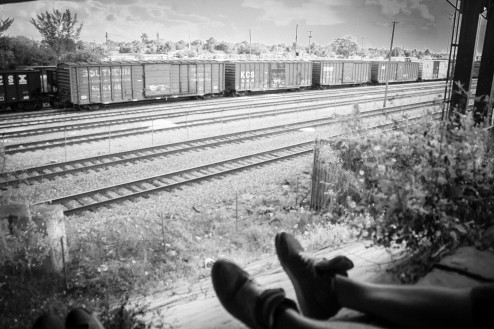
Freight train writing has a long history in America. I would consider it a marriage of the subway art era in New York and the Hobo culture that is rooted in early to mid 1900’s America. I won’t go into the NYC subway phenomenon, as I have written about it exhaustively on other platforms. The jist of it is that NYC youths who began graffiti writing on the walls of the city in the early 70’s quickly learned that writing on subway train cars would expand the reach of their fame to all corners of the city. Modern graffiti writers then took this same concept to freight trains, realizing that a boxcar can travel to locations thousands of miles from where they were painted… Some even cross borders into Canada and Mexico. Trains were being written on long before this time, however. Riding the rails was (and still is) huge part of hobo and vagrant culture in America. People have been marking the trains they ride with grease crayons since the mid 20th century. A friend of mine relayed some stories his father, a train conductor, would tell him about the hobos of this time. In passing, they would ask how “dirty” the line they were pulling had gotten on its trip, referring to the amount of hobo monikers, and hobos themselves, they had inadvertently picked up on the drive. The point here is that writing on trains is all about exposure. The artwork travels, and is seen by more people, and for a longer time, then any painting hanging in a gallery. Whether it was hobos scribing messages to each other, or modern graffiti artists looking to spread their influence, trains are decorated because it is the best way to connect with an otherwise unattainably large audience.
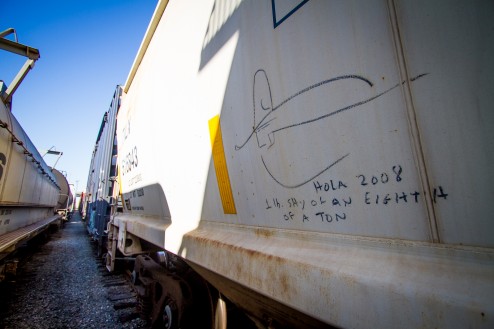
This is the hobo moniker of a man called Colossus of Roads. Now old and gray, but still active, he has been writing on train cars for far longer than I have been alive. He is one of the most respected and revered figures in railfan culture.
Painting on trains is, of course, an illegal (and some would say immoral) activity. Whatever way you want to look at it, it is 100% an act of vandalism. The relationship between freight writers and the actual train companies is anything but friendly. Whether it be the liability of unwanted people entering lay-ups and yards, or the nuisance of the actual graffiti; railcar pooling conglomerates would rather exist in a world without graffiti writers. On the other side of the spectrum, graffiti artists take interest in learning as much as they can about how the logistics of the rails work; for reasons of genuine curiosity and because this information helps them feed their aerosol addiction in a safer, more well informed manner. An example of this is the preservation of identifying markings on the sides of trains. Each train car will have a combination of letters and numbers that allow them to be identified according to what company owns them, and their individual serial numbers. Graffiti writers who have learned the unwritten rules of freight train writing know not to paint over these important markings. That way workers will still be able to properly identify the train car without having to “stamp” the panel (repaint over the graffiti so that the numbers can be restored in a legible manner). Graffiti writers also pay particular attention to the cleanliness of the tracks they paint on. It is a “leave no trace” sentimentality: When done properly, the only evidence of an artist being there is the piece he left on the train. The care that graffiti writers take to make their activities as sustainable and undetectable as possible was particularly interesting to me. The most fascinating part is the fact that if done properly, writing on trains can have absolutely no detrimental effects on the functionality of the railroad’s logistical system. In fact, if particular brands of paint are used in the artwork, graffiti pieces can increase the life of the actual steel they’re sprayed on, delaying the oxidization process substantially. At this point is it truly vandalism or just rolling artwork? Everyone who is reading this will have a predetermined opinion on this manner, but I couldn’t help bringing the question up either way.
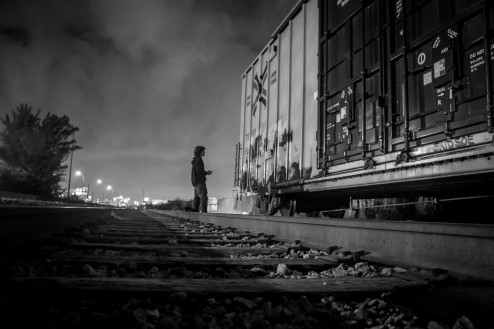
Whatever you may think, I have enjoyed a look into this subculture immensely. While I sympathize with the owners of the train cars when I see improperly painted trains and carelessly littered tracks, I will always experience a childlike excitement when I see true talent shining on these boxcars rolling around America. I have enjoyed watching decorated trains pass since I before could really understand what was happening, and will always perk up to watch them until the day I die. Please enjoy the 100% train-centric gallery below.
